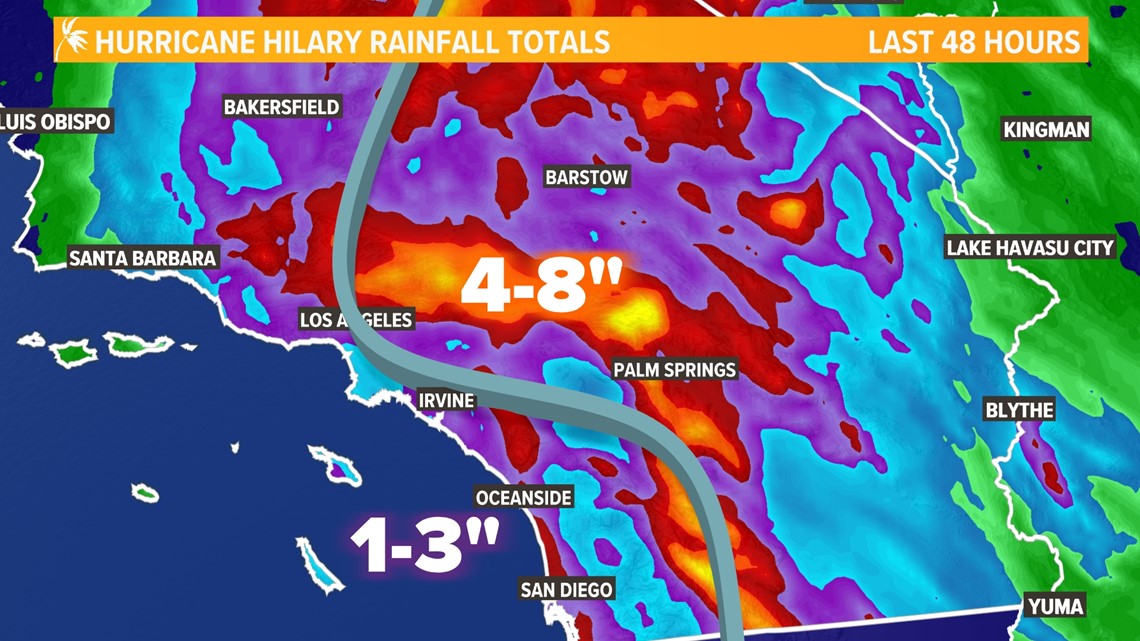Hilary swept through Southern California with a record-breaking overnight visit. According to ABC10 news , “A slight eastward jog in the track of Hilary though Baja California meant the heaviest rain and strongest winds occurred east of the Peninsular Ranges, sparing the densely-populated coastal cities from the worst of the storm… The deserts of Southern California were particularly hard hit, with 4-10 inches of rain falling in places like El Centro and Palm Springs… Many areas saw at least an average year’s worth of rain in 48 hours…” (see screen capture below). (More and more and more and more.)
A late Sunday afternoon magnitude 5.1 earthquake east of Los Angeles contributed an extra dose of Hollywood-like dread to what might happen overnight.
A tropical storm swiping San Diego is entirely different from a hurricane hitting Los Angeles. A tropical storm tearing through the Imperial Valley, Salton Sea, Joshua Tree, and Mojave is very different from four to ten inches in one day for any urban area, Los Angeles Basin infrastructure, or supply chain clusters in San Bernardino County. Wherever “an average year’s worth of rain in 48 hours” occurs, flooding, landslides, and related infrastructure troubles will unfold.
But supply chain clusters and capacity concentrations are highly differentiated by target area. Risk emerges from the interplay of threat with vulnerability. The risk associated with a very hard hit on empty space is nil. The more capacity and interdependencies in any particular place, the more vulnerability to even incidental threats.
In the case of Hilary, the threat was substantive but the storm track happened to spare (that “eastward jog”) the largest inventory of potential vulnerabilities. Our situation today would be very different if, instead of making landfall in Baja, Hilary had come ashore at Long Beach with maximum rain and wind hitting the ports, refineries, urban transportation network, and dense population. (See more on the historical precedent here and here.)
A magnitude-5.1 earthquake in rural Ventura County spawns different consequences than a 5.1 along Ventura Boulevard at the intersection of the 101 and 405. A 7.1 in either place will be horribly destructive. There is, however, much more to destroy in the vicinity of Ventura Boulevard and many more people to harm.
When Ojai or Palm Springs are hit hard, proximity to the supply chain capacity of metro Los Angeles allows for rapid and effective response and recovery. Fort Myers was helped because Tampa was spared. Lahaina is getting more help faster because Kahului continues to operate and Honolulu still receives flow from Oakland, Long Beach, and elsewhere. But when a network’s core capacity is hit hard, response will be constrained and recovery long delayed.
This reality is widely recognized by supply chain and crisis management professionals, but tends to be discounted. The discounting is reinforced by easy-to-anticipate — if hard to predict — catastrophic outcomes (more and more) of losing any major proportion of water, food, fuel, or related supply chain capacity serving a large population. The problems of lost-capacity can seem so overwhelming that many otherwise tough-as-nails veterans are reduced to hoping for another slight jog.
There are mitigation strategies to explore, exercise, and worth our investment of time, thought, and more. In a future post I will list a few. But this morning’s challenge is that rush of dopamine many of us (me too) experience when the bullet just dodged somehow discounts the artillery round still to come.
